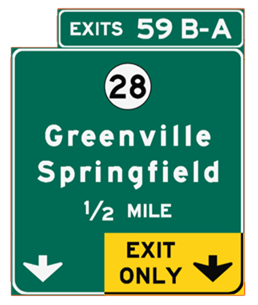U.S. Department of Transportation
Federal Highway Administration
1200 New Jersey Avenue, SE
Washington, DC 20590
202-366-4000
Federal Highway Administration Research and Technology
Coordinating, Developing, and Delivering Highway Transportation Innovations
| REPORT |
| This report is an archived publication and may contain dated technical, contact, and link information |
|
| Publication Number: FHWA-HRT-17-048 Date: May 2018 |
Publication Number: FHWA-HRT-17-048 Date: May 2018 |
1-1 How often do you drive on the freeway or toll roads?
○ Daily
○ Once a week or so
○ Once a month or so
○ Almost never
1-2 What do you find most challenging about driving on the freeway or toll roads?
○ Merging into traffic
○ Knowing just where the exit is
○ Lanes that can go straight or exit
○ Aggressive driving
○ People who block lanes and don’t move over
○ Difficulty reading signs at night
○ HOV lanes and special toll lanes
○ ______________________________________________________________
1-3 Characterize your style of driving on the freeway or toll road.
○ Cautious, I like to drive a bit slower
○ Cautious, generally driving with traffic
○ Confident, generally driving with traffic
○ Confident, generally exceeding the speed of other traffic
1-3 In your opinion, considering how you usually drive and irrespective of laws concerning the left lane, what is the purpose of the left lane on the freeway or toll road?
YOU MAY CHOOSE MORE THAN ONE ANSWER
○ I can drive in it at any time
○ I can use it to pass other people
○ I shouldn’t have to move over, even if I’m going slower
○ If I’m doing the speed limit, I should move over to let faster traffic pass
○ If I’m doing faster than the speed limit, I don’t need to move over to let faster traffic pass
○ I stay out of it unless I’m going to pass someone
○ When I’m in the left lane, I drive faster than the prevailing speed of traffic
○ Sometimes I use the left lane to avoid conflicts with people getting on the freeway and exiting the freeway
Look at the sign in the image below. This sign was used in the driving simulator study.
2-1 Did you notice this sign as you were driving the simulator today?
○ Yes
○ No
2-2 What does it mean?
○ The right lane is ending up ahead
○ The right lane is ending here
○ No lane is ending, but people should move over
○ The left lane is ending
○ ______________________________________________________________
2-3 Where did you see it was placed?
○ A long distance ahead of where the lane ends, as the only sign
○ A long distance ahead of where the lane begins to end, as a second sign
○ Near the beginning of the taper, the point where the lane starts to get narrower before it goes away
○ Cannot recall
2-4 Which of the following signs could be replaced with the sign above?
DRAW A BOX AROUND YOUR CHOICE



A

B
3-1 Considering Sign A only, what happens to the left lane (the lane underneath the white arrow, not the lane underneath the black arrow) in ½ a mile?
○ It must exit to the right
○ It can exit to the right, but people in that lane can go straight to an unknown destination
○ It can exit to the right, but people in that lane can go straight into a dead-end road
3-2 Considering Sign B only, what happens to the left lane (the lane underneath the white arrow, not the lane underneath the black arrow) in ½ a mile?
○ It is a through lane
○ It is an exiting lane, but not an exit-only
○ It is an exit-only lane
3-3 Looking at the signs above, which one do you find most clearly indicates that the second lane from the right could be used for the next ½ mile by both exiting traffic and through traffic?
○ SIGN A
○ SIGN B

A

C
3-4 Looking at the signs above, which one provides clearer direction to Route 28 and Greenville?
○ SIGN A
○ SIGN B
3-5 Considering Sign C only, could a driver in the lane underneath the left-hand side of the sign go straight to get to Route 28 and Greenville? Choose the answer that most closely agrees with your thinking.
○ Yes, by following the up arrow
○ Yes, both arrow heads point to Greenville
○ No, because the left arrow head doesn’t point at anything
○ No, because only the right-hand lane exits
○ There is not enough information to determine this
3-6 Considering Sign A only, could a driver in the lane underneath the left-hand side of the sign go straight to get to Route 28 and Greenville? Choose the answer that most closely agrees with your thinking.
○ Yes, because there is a straight potion to the arrow
○ No, because the arrow head points up and to the right
○ No, because there is no arrow head on the straight-up portion of the left-hand arrow; it exists, but does not point to anything
○ No, because only the right lane exits